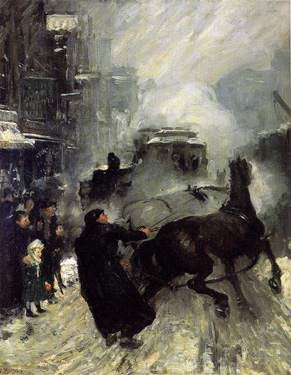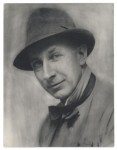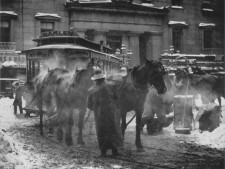
George Wesley Bellows
American, 1882-1925
Steaming Streets, 1908
oil on canvas
38 3/8 x 30 1/4 in.
SBMA, Gift of Mrs. Sterling Morton for the Preston Morton Collection
1960.50

Undated photo of Bellows.
"I found myself in my first art school under the direction of Robert Henri... My life began at this point." George Bellows
RESEARCH PAPER
The only child of a late-married, middle-aged couple, George Bellows was born and spent his early life in Columbus, Ohio, in a conservative family atmosphere, which held practicality, Republicanism, and the First Methodist Church in high regard. Artistic and possessed of a quiet wit, he gave early evidence of a striving for achievement. He found real recognition and an outlet for his robust energy in basketball and, most notably, baseball, turning down an offer to play professional ball with the Cincinnati "Reds" after leaving Ohio State University.
Arriving in New York to pursue his artistic ambitions, he fell immediately under the influence of his teacher, Robert Henri, who was to be his mentor in social thought as well. Because of Henri, he would thereafter be linked with "The Eight," (Robert Henri, George Luks, William Glackens, John Sloan, Everett Shinn, Arthur B. Davies, Maurice Pendergast, Ernest Lawson), who so named themselves when they exhibited together in 1908. Practically all of the group were older than he and had already begun the revolution in changing the artistic trend in America. In the nineteenth century emphasis was primarily on man’s involvement with nature, resulting in the Hudson River School, which was an integral part of our landscape tradition. Now there appeared to be a necessary concern for our cities, industrialization, and the part that European immigrant populations were playing in twentieth century America. The revolution was not one of construction and technique (although the French Impressionists were excitedly involved with light and color) but with subject matter; a new concern for everyday street happenings undiluted in their harsher aspects. The National Academy of Design rejected this new trend, allowing only exhibitors who followed the approved, established and impeccable aesthetic standards to which they themselves adhered. Anxious to display their work, younger painters participated in a series of independent exhibitions between 1908 and 1915. Just as Henri took his place among the outsiders who were rejected by the Academy (although himself a member) George Bellows fought for the independents although he was elected a National Academician only ten years after he began his studies.
"Steaming Streets," painted in 1908, is one of his earlier works before he adopted the doctrine of Dynamic Symmetry, dealing with relationships of flat planes, expounded by Jay Hambridge, who lectured in the field of art analysis. "Steaming Streets" is dealing with a fleeting, highly charged moment during winter in New York when weather and traffic conditions have combined to create havoc in the street. Immediately one feels that the vapors from the melting snow and slush are unsettling the horses and adding to the annoyance of the driver, who is forcibly braking them against the oncoming trolley and team to its left. On the right, a large crane working behind an enclosure makes the thoroughfare even more unpassable. The tension and frustration of the moment is shared by a group of the fascinated spectators to the left who have stepped off the curb to relish the drama. All of the these elements combine to produce a scene, the subject matter of which, the conservative thought of the day held to be unsuitable for works of art. The character of the figures is easily conveyed with little facial or clothing detail. The entire scene is rendered by a broadly brushed, notational style fused with action. It holds together well with its light and dark contrasts. The light areas of the street meet a circular area of steam in the center of the painting and continue on to the top of the scene, veering off to the right and balanced by the darker, solid building on the upper left. The medium-toned trolley and one horse are held as part of the center of interest, the encircling dark horse, two drivers and trolley roof. Again, the crane and surrounding boards are balancing the dark-coated spectators.
Bellows is interested, as always, in presenting a scene rather than conveying a message. Although a socialist, like Henri, it did not occur or appeal to him evidently to use his talent to influence political thought.
Prepared for the Docent Council of the Santa Barbara Museum of Art
J.S.

Photo by Alfred Stieglitz, Terminal, 1892. This image shows the steaming streets of NYC. A frequent subject for artist during severe winters around the turn of the century.
SBMA CURATORIAL LABELS
Though not a member of the group of artists known as 'The Eight', which included his teacher, Robert Henri, the early work of Bellows is typical of the Ashcan School, known for its gritty urban realism. In this brilliant, early work the subject is a scene he could have easily witnessed in midtown Manhattan, where he lived and had a studio. A horse is startled by the steam rising
up from the new subway line below street level. Bellows uses a dark palette and dramatic silhouettes, enlivened by touches of stark white, applied with vigorous strokes of the brush, to capture the incipit violence of this clash between traditional horse-drawn carriage and modern transportation. White paint also captures the breath of the pedestrians as it freezes in midair, the soiled drifts of snow beneath their feet, and the thick, dirty air of a cold winter’s day in the city.
- Let It Snow, 2018
This celebrated painting is from the Preston Morton collection of American art that was given to the museum in 1960. It represents the extraordinary quality of the objects painstakingly searched out by the Morton family and attests to the strength of this part of the permanent collection. Bellows, who died at the relatively young age of 42, is now recognized as one of the greatest of American artists. The subjects that he chose to treat, especially during the formative first decade of the 20th century were based in the gritty, urban experience that he observed on the streets of New York. The sooty palette is energized by gestural swipes of pigment to capture the incipient violence to pedestrians when the old-fashioned horses-drawn carriage must adapt to the newly installed steam heat system, spurting suddenly from the streets below. Bellows chose to exhibit this canvas four times, shortly after its execution; confirmation of its significance to him.
- Ridley-Tree Gallery 2016
